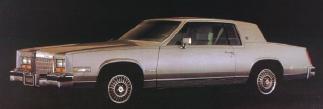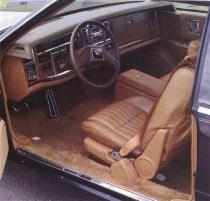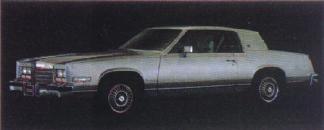
1982 Eldorado
The come-on reeked of seduction: "The leather wrapped steering wheel tightens under your grip as you turn toward the sky. Wide blackwall tires grip the pavement. And for a fleeting moment, you, the road and your Eldorado become one." Eldorado? Indeed. By 1982, sporty European luxury coupes were selling in numbers large enough to goad Cadillac into building a "road machine" of its own. Younger, up-market buyers were overlooking-or just plain ignoring-"The Standard of the World" at a rate that alarmed Cadillac marketing experts. Although devotees of traditional luxury cars still eagerly lined up to purchase their next Cadillac, the average age of Cadillac buyers was increasing. The implications seemed obvious: younger buyers weren't coming into the fold quickly enough to replace the old timers as they died off. If the situation persisted, what would become of Cadillac when its last customer went to his or her last hurrah?
Cadillac thus embarked on a two-stage offensive to ensnare the young blood it would need for its long-term survival. One effort resulted in a hastily conceived baby Caddy, the Cimarron, a spin-off of GM's J-body Chevrolet Cavalier. Targeted to sell in what Cadillac called the "near-luxury" market, it went out to do battle with well-established and respected European sedans such as Saab and Volvo. That success eluded it is another story.
Stage two called for a luxury touring coupe much in the mold of the BMW 633CSi, but priced more in the vicinity of BMW's Three Series coupes. Cadillac's only car remotely close to that area of the market was the Eldorado, but its image and breeding catered to the carriage trade. It was not, on the face of it at least, the type of vehicle that would appeal to rising young professionals looking for a "driver's car."

1982 Eldorado
It had not always been so. The first "personal-luxury" Eldorado coupe of 1967 exuded a sporty image in addition to the obvious -- and expected -- luxury amenities. It borrowed much from the Riviera/Toronado chassis, and all three pursued the market niche originally pioneered by the four-seater Thunderbird in 1958. The Eldo was large as cars go, but a 120-inch wheelbase made it a small Cadillac. Aggressive styling centered on a bold egg-crate grille, and large wheel openings gave it an athletic, road-going look. The 1967-70 Eldorado created a legend for itself while filling General Motors' coffers; 89,633 were built during its four year run.
The second-generation Eldorado completely forsook any sporting pretensions. A bloated body now rested on a wheelbase stretched to 126.3 inches, while curb weight topped two-and-a-half tons. Overnight, the Eldorado had been transformed into a huge luxury barge best suited to easy boulevard cruising. America loved it, however, and showed its appreciation by snapping up 353,542 samples of the 1971-78 models.

1982 Eldorado
Planning for the third-generation Eldorado got underway in the aftermath of the late-1973 Arab oil embargo. GM top brass dictated that henceforth all General Motors products would be downsized to conserve fuel. No car line was to be spared - not even Cadillac. Thus it came to be that GM's full-size offerings appeared in a new, trimmer format for 1977, followed by smaller intermediates for 1978.
By 1979, it was time to redo the E-body cars: Riviera, Toronado, and Eldorado. What emerged must have startled many an Eldorado owner at the time, for the new Eldo represented a complete break with the past. Its wheelbase had been slashed by more than a foot to 114 inches, giving the body a close-coupled look. Overall length shrunk by 20 inches, width by eight inches, and over half a ton (1200 pounds) of body fat melted away in the process.
Cadillac rather immodestly referred to the new Eldorado as "One of the world's best engineered cars." In many respects that was true, because the chassis of the new Eldorado had taken on a great deal of sophistication. In an effort to maintain ride quality, the suspension was totally revamped to include torsion bars up front and independent rear springing, via semitrailing arms, coil springs, telescopic shocks, and an anti-roll bar. In the process, the new E-bodies became the first American front-drivers to feature four-wheel independent suspension. An electronic load-leveling system automatically adjusted the rear suspension to maintain proper ride height under all conditions, and four-wheel disc brakes with staggered vane construction provided rapid heat dissipation for added safety. Cadillac chose Oldsmobile's 350 V-8 with electronic fuel injection to power the Eldo. In this guise it developed 170 horsepower. A 350 diesel V-8 could be ordered as well, but its 120 horses really weren't up to the job of propelling a 3800-pound car.
Style-wise, Cadillac designers did everything within their power to give the downsized car a traditional Eldorado look, even though the proportions were different: relatively larger cabin, shorter front, and smaller deck. As it turned out, passenger space actually increased (except for width) and trunk space was enlarged. Most importantly, the stylists succeeded in maintaining a continuity of design so that the much smaller new car still looked every bit an Eldorado. Taut, crisp lines gave it a formal, elegant look perfectly in keeping with Cadillac's up-market image.
The 1979 brochure enthusiastically noted that "Inside Eldorado, there's a new breed of luxury." That meant 50/45 Dual Comfort front seats, with optional "leather seating areas" in 11 shades. Alternately, a pillow-style interior in Dante knit cloth could be had. "The luxury runs deep to include such fine details as a new functionally co-ordinated instrument panel with simulated burl walnut. New AM/FM electronically tuned stereo radio with signal seeker, scanner and digital display of radio frequencies and time of day. And since the floor is flat with front-wheel drive, there's added roominess, too." If that wasn't enough, the Eldorado Biarritz, "The Ultimate Eldorado," stood by, ready to please. It was decked out with exclusive styling accents, like a Cabriolet roof treatment and cast aluminum wheels, and a special interior, highlighted by "the elegance of one-piece plush Tangier carpeting which simulates fine fur." A living room never had it so good!
From a driver's vantage point, the car had improved in every way. It felt far more nimble, especially around town where the lighter weight and five-foot-smaller turning circle came into play. Whereas the big Eldo plowed through corners even at modest speeds, the new edition would do so only when pushed much harder. It was now an easier car to park, too. Performance with the gasoline engine, while not neck-snapping, rated as more than adequate, zipping from 0-60 mph in 11-12 seconds. Meanwhile, the engineers not only succeeded in maintaining ride quality, but managed to better it significantly by eliminating the wallow of the old car. They also maintained the legendary bank-vault quiet on which Cadillac built it's reputation.
Overall, the third generation Eldorado stood out as a significantly better automobile than its predecessor in virtually every respect. Motor Trend was enthused enough about the new E-body cars to say they were "simply delightful pieces of machinery." But that's not to say the Eldorado had become an enthusiast's car-at least not yet. It was still too soft for that. Meanwhile, BMW and Mercedes continued to go from strength to strength in the American market.
The 1980 Eldorado could be distinguished mainly by checking out the serial number, but for 1981 Cadillac debuted its fuel-injected "variable-displacement" V-8-6-4 engine, installed an On-board Computer Diagnostic System, and gave the grille a finer texture. A Touring Suspension hit the options list, and its popularity surprised Cadillac officials. Unfortunately for Cadillac, the new engine proved trouble-prone. Cadillac's reputation suffered for it, so it was soon discarded.
The 1982 model year found Eldorado sporting three horizontal bars in the grille and wearing an extra-cost full-length cabriolet top. A new HT 4100 V-8 replaced the ill-fated V-8-6-4. But that wasn't all-the Eldorado Touring Coupe had arrived. Cadillac said it was "Created for the person who loves to drive." The heart of the Touring Coupe, or TC as Cadillac sometimes called it, could be found underneath in the Touring Suspension. It featured stouter stabilizer bars front and rear (32 mm and 26 mm, respectively), 20 percent stiffer front torsion bars, 15 percent firmer rear coil springs, vastly stiffer shocks, and recalibrated SuperLift air shocks for the automatic level control. Even the suspension grommets were made of 70 durometer rubber, rather than 60 dm as on the standard coupe. The power steering kept its 14:1 ratio, but required more effort, which resulted in increased feedback to the driver. The standard P205/75Rl5 steel-belted radials were upgraded to P225/70Rl5 for tauter handling. Cadillac said the changes helped result in "a firm 'feel-the-road' responsiveness."
Cadillac's new 4.1-liter HT 4100 engine featured a light-weight aluminum block, 90-degree design, and Digital Fuel Injection. It provided 10 more horsepower and 10 lbs/ft more torque, bringing the ratings to 125 bhp at 4200 rpm and 190 lbs/ft at 2000 rpm. The engine was mated to a fourspeed overdrive transaxle with lockup torque converter, running through a 3.15:1 final drive ratio.
Styling touches for the Touring Coupe included ribbed rocker panel moldings, aluminum wheels with center hubs, and three cloisonné medallions (one for the hood, in lieu of the stand-up hood ornament, and one on each sail panel). Black paint replaced bright metal on reveal moldings and headlight and taillight bezels, and the solid black bumper rub strips lost their chrome trim. Inside, the driver and passenger sat on gray reclining leather-faced bucket seats with lumbar and lateral support, while enjoying the convenience of a front seat console. The seats, by the way, reportedly came from the Cimarron. The 1982 TC was offered only in Sterling Silver paint, accented with red over black striping. And to prove that Cadillac meant business about the Touring Coupe, whitewall tires and vinyl roofs were not part of the package, nor were they available even at extra cost. The Touring Coupe package listed for $1950 in 1982, on top of the $18,716 list price for the base coupe.
For 1983 and 1984, the Touring Coupe went largely unchanged, but was offered in two colors: Sonora Saddle Firemist and Sable Black. A saddle-colored interior complemented the exterior. For 1985, the colors were changed to Bordeaux Red and Sable Black, with Sandalwood interior.
Reaction to the Touring Coupe was mixed. Motor Trend declared it "a truly impressive handler for a car of its mass," and that with it "the sheer fun of driving is way up." Popular Science disagreed, commenting that the suspension felt only "slightly" firmer, and that "it was difficult for us to detect any real handling advantage." However, everybody agreed on two points: the Touring Coupe was exceptionally quiet and smooth-and slow. A 0-60 run, for example, took about 15 seconds. And complaints occasionally surfaced that the overdrive automatic transmission tended to "hunt" for the right gear, especially on inclines and in 35-40 mph suburban driving. The interior also came in for criticism for having too much brightwork. But when all was said and done, the majority agreed that the Touring Coupe was likely the best Eldorado yet, and a step in the right direction for Cadillac in the Eighties.
In terms of collectibility, one has to remember that Cadillac built a total of 454,405 third-generation 1979-85 Eldorados. Nonetheless, the Touring Coupe offers excellent possibilities as a future collectible. Consider the production figures: 1982, 1700; 1983, 1197; 1984, 815; 1985, 585. That means only 4297 Touring Coupes were built during its four-year life span. And since the TC disappeared with the introduction of the even-further-downsized 1986 Eldorados, there won't be any more. Richard M. Langworth, in the Illustrated Cadillac Buyer's Guide, speculates: "... it seems obvious that the low-production Touring Coupe will have a strong following among collectors ten or twenty years down the line ... although these cars are still in the depreciation stage, and it's difficult to say when they will bottom out in value and start rising." Nonetheless, it seems inevitable that they will begin to appreciate after a certain point, and that they will become legitimate collector cars somewhere down the road. The only question is when.
Moral? If you have one, keep it. If you want one, buy it while you can get it at used car prices.